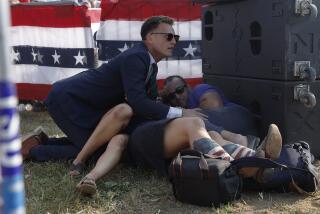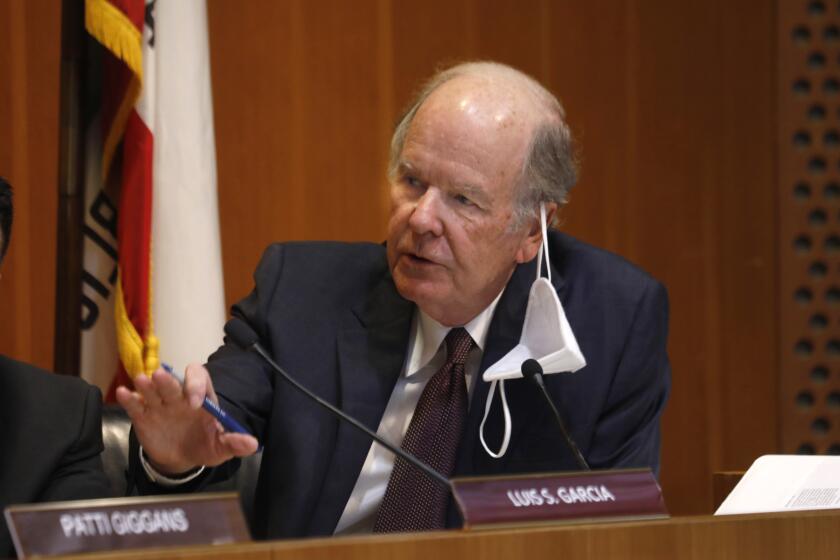Facing Up to Our <i> Real </i> Gun Problem
- Share via
America thinks it has a gun problem. In fact, it has two.
One has been contested for nearly 30 years on public platforms, newspaper editorial pages and radio talk shows. In legislative chambers from Washington to Sacramento, lobbyists and lawmakers, lawyers and political action committees have bickered and bargained, disputing questions of criminology, traditional values and intractable issues of constitutional interpretation.
The other gun problem is real, and is being fought out in deadly earnest. It has turned our streets into battlegrounds and hospital emergency rooms into charnel houses. Every day it threatens the life of every person in this country.
George Hennard, who last month used a 9-millimeter Glock semiautomatic pistol to kill 23 people and wound 20 more in a Killeen, Tex., cafeteria, is a part of the real gun problem.
Gang Lu, the disappointed young physicist who last week used a .38-caliber revolver to kill a fellow student, three professors and an administrator at the University of Iowa, is a part of the real gun problem.
The pawnshops in South-Central Los Angeles that sell individual .357 magnum cartridges for 40 cents each are a part of the real gun problem.
The students of Banning and Dorsey high schools who were prevented from playing a championship football game by the threat of armed gang violence are victims of the real gun problem.
The 1,000 drive-by shootings that have occurred in Los Angeles County since January are a product of the real gun problem.
But if you want to see cause and effect at work in the real gun problem, drive down Olympic Boulevard to San Vicente, where the Miracle Mile district runs into Carthay Circle. It is an economically and racially diverse area, a little south of Beverly Hills, a little north of south L.A. There, back-to-back on the same block, you will find Midway Hospital, a bustling state-of-the-art medical facility, and Gun Heaven, a bustling purveyor of state-of-the-art firearms.
Gun Heaven sits in a tiny strip mall sandwiched between a doughnut shop and a dry cleaner. It’s a cheerful place whose fluorescent window signs proclaim a “Year End Blow Out Sale” in progress. But when I identified myself inside, a clerk named Terry declined to answer any questions. The owner had forbidden it, he said. There had been “trouble with you guys” before. It’s not hard to guess why.
The store’s large stock includes a handful of bolt-action sporting rifles and a couple of over-and-under shotguns suitable for hunting. The balance of the inventory consists of firearms designed solely for use against human beings. There are military-style rifles with large, detachable magazines and folding stocks. There are short-barreled pump shotguns with pistol grips instead of stocks--easily concealable and just the thing for your next convenience store stickup. There is a variety of machine pistols, Scorpions, Ingrams--not very accurate, but handy if you want to spray a crowd, say in a front yard, from a moving car. For $1,025 you can buy the civilian model of the military’s AR-15, with a 30-shot banana clip and a 12-gauge shotgun mounted underneath the forearm. Improbable, but impressive in a paranoid sort of way.
And, from the case containing dozens of other semiautomatic handguns, you can buy the same Austrian-made Glock that George Hennard used in the Killeen massacre.
Next door, at Midway Hospital, Dr. Jason Toth, an emergency room physician who became familiar with gunshot wounds during three years’ training at the county’s Martin Luther King Jr./Drew Medical Center was less reticent than the clerk at Gun Heaven.
“We actually see more than our fair share of gunshot wounds for a private city hospital. Two nights ago (Monday) we had five different individuals who sustained gunshot wounds to the extremities. Last night, there were two more. So, within a period of 48 hours this private community hospital has treated seven people who have sustained gunshot wounds.”
What are such injuries like? “When they occur in the extremity, that is in the arm or leg,” he said, “it’s as if you were to take a nail and hammer and actually make a hole in your body and then try and move the nail all around. That’s the equivalent of getting a high-velocity gunshot through your skin and muscle and soft tissue.”
What does Toth think of the ready availability of firearms in stores like the one down the block? “I think it’s disgusting. I’m a very ardent believer in gun control. I don’t believe people ought to have the right to own anything other than a purely sporting weapon.
“I’m not moved by these arguments over the Second Amendment. I just don’t think they hold water. I don’t see any defensible reason to allow people to possess these non-sporting weapons. If it were up to me, I’d just ban all handguns and assault rifles.
“At some level this problem speaks to Americans’ fixation on choice, on their relentless determination to have the ability to choose regardless of whether it’s cigarette smoking, or purchasing alcohol or wearing helmets on motorcycles or buying guns. Despite the fact that statistically we’re the most violent society in the world and can attribute more deaths to alcohol and smoking each year than to the war in Vietnam, there’s just a peculiar American insistence that these things are somehow associated with their personal rights.”
America’s gun problem, as it usually is debated, is the product of that willful insistence on choice--even if it is destructive. The gun problem with which we live--and by which too many among us die--is there to see on that block on Olympic Boulevard. In the end, it is just another story of commerce and consequence.
More to Read
Sign up for Essential California
The most important California stories and recommendations in your inbox every morning.
You may occasionally receive promotional content from the Los Angeles Times.













